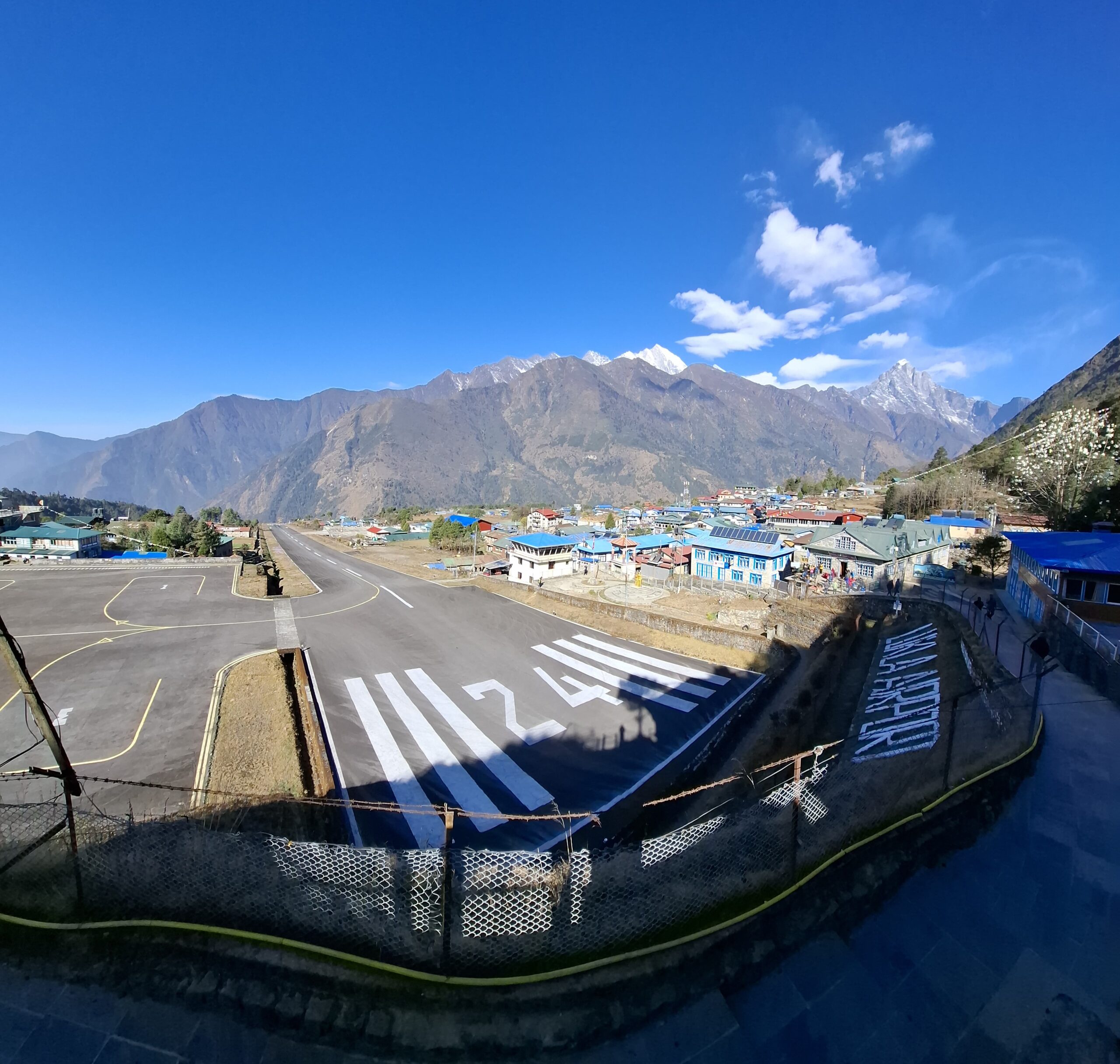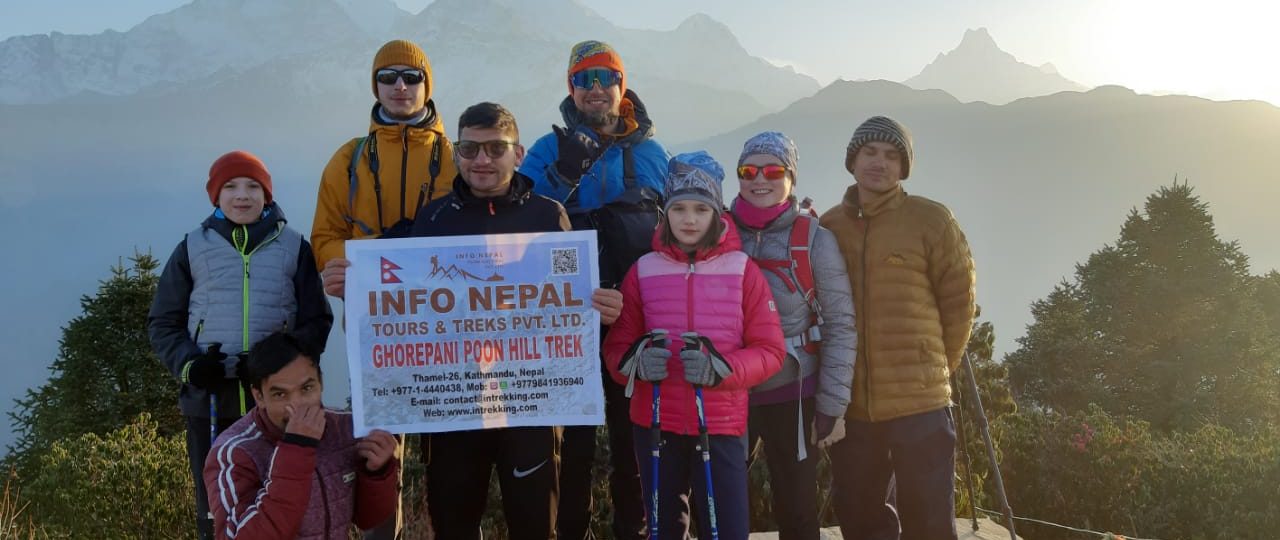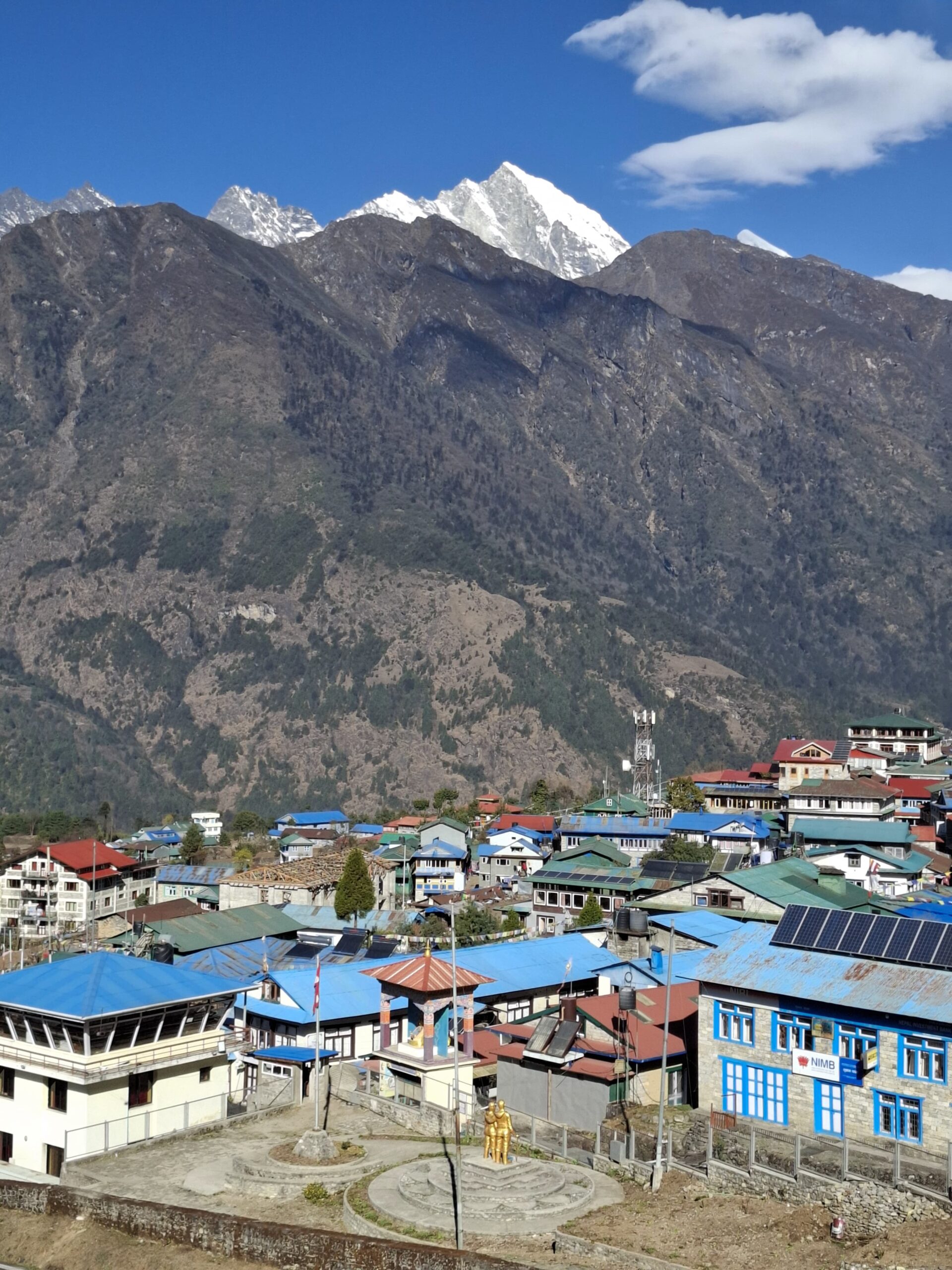
 Written By: Rajesh Neupane
Written By: Rajesh Neupane
Exploring Lukla
- Introduction
- 1. What makes Lukla special and unique?
- Gateway to Everest
- Strategic Location
- 2. The infamous Tenzing-Hillary Airport.
- A history of adventure
- Safety measures for trekking
- 3. Lukla’s surroundings: A trekker’s paradise.
- The Khumbu region
- Local culture
- The Sagarmatha National Park
- 4. Trekking from Lukla. What to expect?
- Everest Base Camp trek.
- The Gokyo Lakes
- Three Passes trek
- Accommodations and teahouses during travel
- Trek Challenges and considerations for travellers
- Altitude sickness during the trek
- Unpredictable weather during the trek
- Physical preparation for the trek
- Conclusion: Lukla as a landmark of adventure trek
- Final thoughts on the trip
- FaQ about the Lukla trek
Enquiry Form
Introduction
Nestled in the heart of the Khumbu region of Nepal, Lukla is a small town that serves as a gateway to the majestic Mount Everest. While it’s primarily known for its airport- Tenzing- Hillaryairport, one of the dangerous airports in the world- it also most cultural, historical and natural significance for travellers embarking on one of the most iconic trekking routes on the planet. In this blog, we’ll explore Lukla’s most unique aspects, its role in adventure tourism, and what you can expect when visiting this thrilling town.
1. What makes Lukla special and unique?
Lukla‘s reputation precedes it, primarily because of it’s airport but there’s more to Lukla than just being the starting point for Everest Base Camp treks. Thai section covers why Lukla is an iconic destination and how it draws adventurers and trekkers from around the world.
Gateway to Everest
Lukla is the first stop for trekkers aiming to reach Everest Base Camp. After a dramatic flight over the Himalayas, adventurers are greeted by the towering peaks of the region, with Everest looming in the distance. It’s here that their journey begins- weather trekking to Everest base camp, embarking on the three passes Trek, or making their way to Everest base camp, embarking on the three pass trek is not just s trip but a rite of passage for those with love for adventure, and Lukla is where that rite begins.
Strategic Location
Lukla’s location is at an altitude of 2,860 meters (9,383 ft), making it an essential part of an Everest-bound adventure. The town, though small, is an essential part of the trekking network, offering various accommodations, supplies, and services to trekkers before they continue their journey into the Everest region. What makes Lukla especially important is its status as a launch point for the expeditions and treks into the boarder Khumbu region, which is home to some of the most stunning landscapes and wildlife in the world.
2. The infamous Tenzing-Hillary Airport.
No conversation about Lukla is complete without discussing its airport. Tenzing Hillary Airport, named after the famous mountaineer Sir Edmund Hillary and Tenzing Norgay Sherpa, is located in a dramatic setting with a short runway and a precarious drop at both ends, making it one of the most exciting, nerve-wracking airports in the world.
The airport’s runway is just 527 meters long (1,729 ft) and is located on the mountain ridge, making take-offs and landings a real thrilling challenge for pilots. The approach is complicated by steep slopes and ever-changing weather conditions, making it an exhilarating experience for anyone who has flown there. Only skilled pilots with specific training in landing at high-altitude airports are allowed to fly into Lukla. As such, the journey into Lukla is an adventure in itself, with breathtaking views of the mountains that awe-struck any travellers.
A history of adventure
The airport was first opened in 1965 and since then, has been an integral part of the region& trekking infrastructure. It connects Lukla with Kathmandu, making it much easier for trekkers to access the Everest region. Despite its dangers, it has become a symbol of adventure and is often featured in stories about trekking to Everest. The airport has witnessed some close calls, which only adds to its mythos, and it’s a point of excitement for travellers to say they’ve flown
there.
Safety measures for trekking
While the airport is known for its dangers, there are numerous safety measures in place. Pilots undergo rigorous training, and flights are cancelled or rerouted if weather conditions are unfavourable. Additionally, new technology is being implemented to improve the landing and take-off procedures. For trekkers and tourists, there is a certain thrill in knowing that they are travelling into one of he most challenging airports in the world- this experience is part of the
adventure.
3. Lukla’s surroundings: A trekker’s paradise.
Lukla is not just about the airport – a it’s a hub for the trekkers and adventurers looking to experience the beauty and serenity of the Everest region. The town itself is surrounded by stunning natural landscapes that provide ample opportunities for trekkers to explore and enjoy the Himalayan beauty.
The Khumbu region
The Khumu region, which Lukla is part of, is home to some of the world’s most spectacular trekking routes, including the famous Everest base camp trek. Along the way, trekkers pass through surrounding towers and snow-capped peaks. The scenery along these routes is nothing short of breathtaking, with vistas that include glaciers, alpine meadows, and some of the highest mountains on earth, as trekkers pass through villages like Namche Bazaar, Tengboche, and Dingboche, they experience the unique blend of the natural beauty and local culture that defines
the Everest region.
Local culture
The Sherpa people, the ethnic group native to the Everest region, call Lukla home. Their culture is deeply intertwined with mountains, and their hospitality and traditions make the trekking experience even more enriching. Trekking often stays in Sherpa-run teahouses along the route, enjoying traditional Nepali meals and experiencing Sherpa hospitality first-hand. Visitors have the chance to learn about the culture and traditions of the Sherpa, such as the Buddhist religion, the role of the monasteries, and’s historical significance of the Everest expeditions. The locals’ deep connections to the mountains are an essential part of the region’s charm.
The Sagarmatha National Park
Lukla is located within the Sagarmatha National Park, a UNESCO World Heritage Site. The park is. Unique flora and fauna, including the elusive Snow leopard, Red Panda and Himalayan tahr. The Park’s bio-diversity adds an extra layer of fascination to the trek, It is a great place for wildlife enthusiasts to explore. In addition to its rich wildlife, the park offers a chance to experience the natural beauty of the Everest region in its purest form, with unspoiled forest, pristine lakes and expansive views of the Himalayan Mountain range.
4. Trekking from Lukla. What to expect?
Lukla serves as the starting point for several of Nepal’s most famous trekking routes. Whether you are aiming for Everest Base Camp, the Gokyo lakes or exploring the three passes trek, Lukla marks the beginning of an unforgettable adventure. This section provides an overview of what trekkers can expect when they set off from Lukla.
Everest Base Camp trek.
The Everest Base Camp Trek is one of the popular and challenging trekking routes in the world. Starting in Lukla, Trekkers head towards Namche Bazaar, the region’s bustling hub. From there, the journey takes you through the Iconic village of Tengboche and Dingboche before finally arriving at Everest Base Camp, where the sheer scale of Mount Everest can be felt up close. The trek involves several days of high-altitude hiking at high elevations, and trekkers should be prepared for the physical demands of the route. However, the rewards are unparalleled: views of the world’s highest peak, a chance to visit the Khumbu Glacier and an experience of sherpa culture in its most authentic form.
The Gokyo Lakes
For those looking for slightly less-crowded but equally spectacular adventure, the Gokyo Lake trek offers a serene alternative. Located to the west of Everest, this trek takes you to a series of high-altitude lakes with crystal-clear waters, surrounded by snow-cocered peaks.the trek is abit more difficult for thiseo wanting to experience the Himalayas in a more tranquil setting. Along he way, trekkers can explore the Gokyo Ri peak, which offers some of the best panoramic
views of the Everest region.
Three Passes trek
The three passes trek is a challenging circuit that involves crossing three high-altitude passes: Kongma La, Cho La and Renjo La. This trek offers trekkers incredible views and its surrounding peaks, and it’s perfect for those for a noff-the -beaten camp route and involves more strenuous hiking, but the sense of achievement when completing the passes is immensely rewarding.
Accommodations and teahouses during travel
Lukla has several accommodations ranging from basic guest houses to more comfortable lodges. As you head deeper into the Everest region, teahouses offer simple but cosy stays, with warm meals and a place to rest. many trekkers enjoy the communal atmosphere of the tea- houses, where they can swap stories with fellow adventurers. Accommodation along, the
trekking routes is fairly basic but comfortable enough for trekkers to recharge for the next day’s
trip.
Trek Challenges and considerations for travellers
While Lukla is undoubtedly a beautiful and awe-inspiring destination, it also presents a few challenges for travellers. Trekking in the Everest region requires preparation, both physically and mentally.
Altitude sickness during the trek
Lukla’s elevation of 2,860 meters (9,383 ft) is a significant starting point for trekkers heading into the higher Himalayas. Altitude sickness can be a concern for those who are not acclimatised, so it’s important to take things slow, drink plenty of water, and allow time for the body to adjust. Symptoms can range from mild headaches to nausea to more severe cases of acute mountain sickness (AMS), so it’s crucial to know the limits and rest when the body asks.
Unpredictable weather during the trek
The weather in the region can be unpredictable, especially during the monsoon season (June- September) and the winter months (November-February). Trekkers should be prepared for sudden changes i weather, including snowstorms, rain, and strong winds. It’s crucial to check the forecast and remain flexible with travel plans. In some cases, flights to and from Lukla may be delayed or cancelled due to weather conditions, so it’s a good idea to allow extra days for
contingencies.
Physical preparation for the trek
The treks in the Everest region are physically demanding, requiring endurance and stamina. It’s essential for trekkers to train in advance and be prepared for long day of hiking at high altitudes. Proper fitness is key to avoiding exhaustion aand injury, especially during the more difficult sections of the trek.
Conclusion: Lukla as a landmark of adventure trek
Lukla is much more than just a gateway to Evereest, it’s place where adventure meets awe-inspiring natural beauty, steeped in cultural cultural significance and thrilling challenges. Whether you are flying int othe famous airport or setting off on a trek to Everest base camp, Lukla promises and unforgettable experience that will leave you with memories to last a lifetime.
From its rugged terrain to the welcoming Sherpa culture, Lukal remains a beloved destination for trekkers worldwide. The airport’s reputation that defined by the spirit of adventure. Lukla isn’t just a stop on the way to Everest; it’s a part of the journey itself.
Final thoughts on the trip
If you’re planning to visit Lukla, remember that preparation is the key. Whether you’re trekking for the first time or returning for another adventure, be sure to pack accordingly, acclimatize properly, and embrace teh challenge that comes with the trekking in the Himalayas. Lukla’s beauty, adventure, and cultur will make the journey well worth it. Call to action
Have you been to Lukla or treated in the Everest region? Share your experiences and tips with us in the comments below!
FaQ about the Lukla trek
1. Where exactly is Lukla located?
Lukla is a small village in the Khumbu region of Nepal, located at an altitude of 2,845 m (9,334 ft), It’s the starting point for most treks to Everest Base Camp.
2. Why is Lukla airport considered dangerous?
Lukla airport, officially known as Tenzing Hillary Airport, has one of the shortest and steepest runways in the world, built on sloped cliff. Rapid weather changes and high altitude make landings challenging.
3. Can I fly Lukla directly from outside of Nepal?
No, you’ll need to firstly fly into Kathmandu, Nepal. From there, you can take a domestic flight to
Lukla.
4. What is the best time to visit Lukla?
The best seasons to visit are spring (March-May) and Autumn (September- November) for clear skies and stable weather.
5. How long should i stay in Lukla?
Most trekkers stay just a night before or after the trek. But staying an extra day lets you explore
the village and acclimatize better.
6. Is accommodation available in lukla?
Yes, Lukla has plenty of teahouses and lodges. They range from basic to slightly more
comfortable setups, but don’t expect luxury.
7. Do i need a guide to explore Lukla?
No guide is needed just to explore Lukla itself. But if you’re trekking further ( like to Everest
basecamp), hiring a guide a guide or porter is highly recommended.
8. How cold it gets in Lukla?
Temperatures vary but can drop below freezing at night, especially ib the winter months. Always
check the forecast and layer up.
9. Is altitude sickness concern in Lukla?
Though not extreamly high, some people do feel mild symptoms due to sudden gain in
elevation. Resting a day in Lukla helps.
10. Is there electricity and internet in Lukla?
Yes, but it’s not always reliable. Most lodges offer Wi-Fi for fee, but the conection is slow.
Powercuts are common
11. Can i buy trekking gear in Lukla?
Yes, but prices are higher than Karthamandu and selection is limited. It’s best to buy your main gear before arriving.
12. Are there Atm’s in Lukla?
There is one or might be two, but it’s advisable to always carry adequate cash.
13. What kind of food is available in Lukla?
You’ll find everything from Dal Bhat to pancakes, momos and instant noodles. Meals are often simple but filling.
14. How is the healthcare situation in Lukla?
There’re few health posts and basic medical services, but for anything serious, evacuation to kathmandu is necessary.
15. Can i do short trek from Lukla without going to EBC?
Short treks to places like Phakding or even up to Namche Bazaar and back are great options.
16. Is Lukla family-friendly for travelelrs with kids?
Yes, but it depends on the child’s age and health. High altitude can affect kids differently, so
consult your doctor first.
17. What should i pack for Lukla?
Essentials include layers of clothing, a water-purifier, headlamp, first aid kit, snacks and trekking shoes. Don’t overpack.
18. Are there any cultural norms to be aware of?
Yes, always walk clockwise around religious shrines, greet with “Namaste” and dress modestly.
19. Do i need permit to enter Lukla?
Yes’ you’ll need a TIMS card and a Sagarmatha National Park Entry Permit, which are usually checked just after Lukla.altitude can affect kids differently, so consult your doctor first.
20. What’s one thing most travellers miss about Lukla?
The soul of the village. People often rush through, missing and stillness, the small interactions, and the magic that happens after the noise fades.
21. Is it possible to reach Lukla without flying?
Yes, it’s possible though it takes longer. You can take a jeep from Kathmandu or Jiri or Phaplu and then trek to Lukla. This route takes several days but is scenic and a great option if flights are cancelled or if you want to experience the trip the old-school way.
